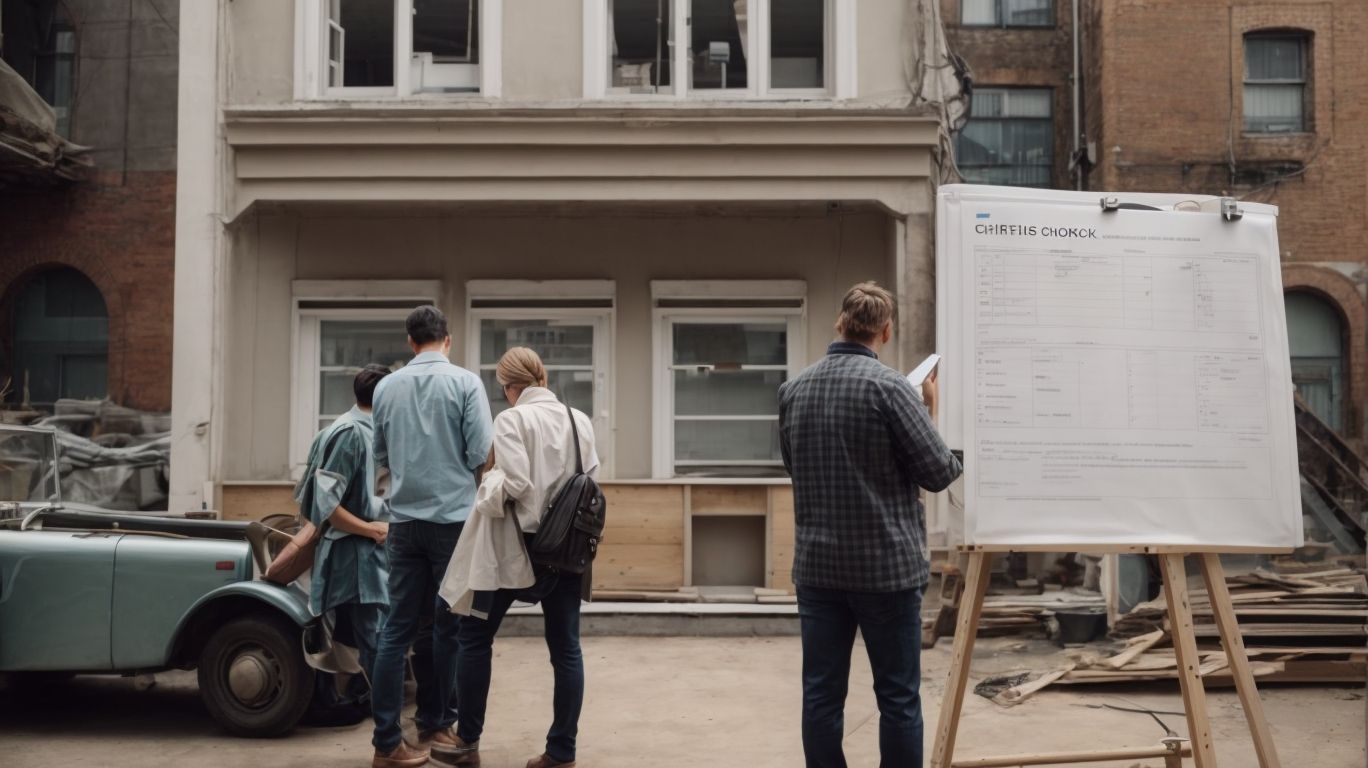
The Complete Checklist for SF Property Owners: Preparing for a Soft-Story Retrofit
If you own property in San Francisco, you may have heard about the importance of a soft-story retrofit. But what exactly is it, and why is it necessary?
Who is responsible for carrying out the retrofit, and what are the steps involved? In this complete checklist, we will cover everything you need to know about soft-story retrofits, including the costs, time frame, and benefits.
We will provide tips on how to prepare for the retrofit, including notifying tenants, securing funding, and making alternative living arrangements. Whether you’re a property owner or a concerned tenant, this article will guide you through the process of preparing for a soft-story retrofit.
What Is a Soft-Story Retrofit?
A Soft-Story Retrofit is a structural upgrade made to buildings in San Francisco, typically to reinforce their resistance to seismic activity and comply with building regulations and earthquake safety standards.
This retrofit specifically targets buildings with weak or open front wall lines, which are vulnerable to collapse during an earthquake.
By implementing a soft-story retrofit, building owners can significantly improve the seismic resilience of their structures, reducing the risk of damage and potential loss of life.
This proactive measure aligns with San Francisco’s commitment to enhancing the safety of its built environment and mitigating the impact of seismic events, ultimately fostering a more resilient and secure cityscape.
Why Is a Soft-Story Retrofit Necessary?
A soft-story retrofit is necessary due to the vulnerability of building structures with open or weakened ground floors, which pose significant risks during seismic events unless strengthened to meet compliance requirements for seismic strengthening.
Structural vulnerabilities are a common issue in buildings with soft-story configurations, making them more susceptible to collapse during earthquakes. These buildings have large openings and minimal support on the ground floor, which can result in disproportionate damage compared to other parts of the structure.
Assessing the risk associated with these vulnerabilities is crucial in determining the need for retrofitting to improve the building’s resilience. Retrofitting not only addresses structural weaknesses, but also ensures compliance with seismic strengthening requirements, ultimately reducing the potential impact of earthquakes.
Who Is Responsible for a Soft-Story Retrofit?
The responsibility for a soft-story retrofit typically falls on SF property owners, who are required to communicate with tenants, ensure compliance with retrofit requirements, and oversee the process to achieve retrofit compliance.
This communication is vital as it helps in informing tenants about the retrofit project, timelines, and any disruptions that may occur.
Property owners must ensure that all necessary compliance requirements are met, including obtaining the appropriate permits and adhering to engineering standards.
Managing the retrofit process involves coordinating with contractors, inspectors, and tenants to minimize disruptions and ensure that the retrofit project is completed successfully.
Ultimately, achieving retrofit compliance is essential to enhance the safety and resilience of the building, protect tenants, and comply with local regulations.
What Are the Steps for a Soft-Story Retrofit?
The steps for a soft-story retrofit involve determining the need for retrofit, hiring a structural engineer, obtaining construction permits, creating a retrofit plan, selecting a contractor, and scheduling inspections to oversee the retrofit process.
Once the need for retrofit is established, the next crucial step is engaging a qualified structural engineer. This professional will evaluate the building’s structural integrity and design a retrofit plan that meets the necessary safety standards.
Subsequently, obtaining construction permits becomes imperative before the commencement of any retrofit work. After the permits are secured, the retrofit plan is developed in collaboration with the structural engineer. This plan outlines the modifications and enhancements required to reinforce the soft-story building effectively.
Selecting a reputable, experienced contractor is pivotal to ensure the retrofit is executed with precision and adherence to guidelines. Throughout the process, scheduling regular inspections is essential to monitor the retrofit progress and verify compliance with safety regulations.
Determine if Your Building Needs a Retrofit
Before proceeding with a soft-story retrofit project, property owners need to assess if their building requires seismic retrofitting through an engineering report and structural analysis.
This evaluation process is crucial as it helps ascertain the structural integrity of the building and identify potential vulnerabilities to seismic activity.
Obtaining an engineering report is a crucial step, as it provides a detailed assessment of the building’s current state and outlines the necessary steps for reinforcement.
Following this, a thorough structural analysis is carried out to determine the specific retrofit requirements, such as reinforcements to existing walls, installing steel frames, or adding shear walls to enhance the building’s resistance to seismic forces.
These comprehensive evaluations and reports are essential for ensuring the effectiveness and safety of the retrofitting process.
Hire a Structural Engineer
Property owners need to engage a qualified structural engineer with expertise in seismic strengthening and code compliance to assess the building’s structural needs for the soft-story retrofit.
Our team of engineers possess the expertise and qualifications to conduct thorough evaluations of soft-story structures, taking into account their specific requirements. This enables us to address all aspects of seismic strengthening and code compliance in our proposed solutions and designs.
With their extensive knowledge and experience, our engineers are able to provide tailored solutions that effectively address the vulnerabilities of each building. By partnering with a structural engineer, property owners can have confidence in the safety and structural integrity of their soft-story retrofit, knowing that it will be carried out in accordance with the latest building codes and standards.
Obtain Necessary Permits
Securing construction permits in compliance with local regulations is essential for initiating a soft-story retrofit project. The approval of permits is a critical step in the process.
Undertaking a soft-story retrofit requires strict adherence to local authorities’ specific requirements. This includes obtaining necessary permits to ensure the project meets safety standards and building codes. Doing so safeguards the property’s structural integrity and occupants’ well-being.
Permit approval serves as official acknowledgment and endorsement of the planned retrofit. It provides assurance to stakeholders, such as property owners and tenants, regarding the legitimacy and diligence of the proposed construction work.
Create a Retrofit Plan
Developing a comprehensive retrofit plan, including seismic retrofit strategies and reinforcement design, is crucial for outlining the scope and approach of the soft-story retrofit project.
This plan allows engineers and architects to assess the existing vulnerabilities of the structure. It also helps identify the best retrofit techniques to enhance its resilience and determine the most suitable reinforcement design.
By integrating seismic retrofit strategies into the plan, the focus is on minimizing potential damage and ensuring the building can withstand seismic events. This approach provides a systematic way to implement necessary modifications, ensuring that the soft-story retrofit meets required safety standards and regulations.
Hire a Contractor
Selecting a qualified contractor with expertise in soft-story retrofitting, managing construction costs, and overseeing project management is essential for the successful execution of the retrofit work.
When it comes to soft-story buildings, it’s crucial to hire a professional who understands the unique structural challenges they present. This expert should be able to develop a comprehensive plan to address these challenges and manage construction costs effectively. They will source materials and labor efficiently while maintaining safety and quality standards. With their project oversight, the retrofit will be completed on time and within budget, providing peace of mind to the building owner and ensuring the stability and safety of the structure.
Schedule Inspections
Scheduling regular inspections is crucial for ensuring compliance with retrofit requirements and documenting construction progress. This is vital to monitor the quality and adherence of the soft-story retrofit work.
Inspections are crucial for verifying that structural improvements are implemented according to guidelines. Conducting thorough inspections at various stages allows regulators and building officials to confirm compliance. These inspections also document construction progress, serving as a record of quality and adherence to codes and standards. They are also valuable for evaluating the effectiveness of retrofit measures and ensuring structure safety and stability.
Complete Retrofit Work
Concluding the retrofit work within the stipulated construction timeline, through effective contractor coordination, is crucial to achieving the successful completion of the soft-story retrofit project.
This final phase requires meticulous planning and efficient communication among all parties involved. It is imperative to ensure that all aspects of the retrofit are addressed and completed as per the timeline to meet safety standards and regulatory requirements.
Coordinating closely with the contractors to monitor progress, address any potential obstacles, and maintain adherence to the construction schedule is vital. This stage demands precision and attention to detail to successfully bring the soft-story retrofit project to a close within the specified timeline.
What Are the Costs of a Soft-Story Retrofit?
The costs of a soft-story retrofit encompass construction expenses, compliance requirements, and potential financing considerations, which collectively contribute to the financial aspects of the retrofit project.
Construction costs play a crucial role in the overall financial outlay for a soft-story retrofit. They involve structural enhancements, materials, labor, and engineering expenses.
Compliance requirements such as permits, inspections, and adherence to building codes are essential components that contribute to the project’s financial considerations. Delving into potential financing options, securing loans, grants, or exploring tax credits could significantly impact the funding and overall affordability of the retrofit. Therefore, understanding the interplay between these elements is crucial for a comprehensive assessment of the financial implications.
How Long Does a Soft-Story Retrofit Take?
The duration of a soft-story retrofit project is influenced by the construction timeline, the complexity of the retrofit process, and effective project management that collectively determine the time required for completion.
The construction timeline plays a crucial role in determining the overall duration of the retrofit project. Factors such as obtaining permits, material lead times, and coordinating the construction work within specific timeframes heavily influence the project’s timeline.
The complexity of the retrofit process also adds to the duration, as intricate structural modifications and installation of seismic reinforcement require careful planning and execution. Effective project management, including scheduling, coordination, and communication, is essential for streamlining the process and ensuring timely completion of the retrofit project.
What Are the Benefits of a Soft-Story Retrofit?
A soft-story retrofit offers numerous benefits, including enhanced earthquake safety, property upgrades, and overall improvements in building safety and structural resilience.
Enhanced earthquake safety is one of the most significant advantages of a soft-story retrofit. By reinforcing the building’s structural integrity, it reduces the risk of collapse and minimizes potential damage during seismic events.
Property upgrades resulting from a retrofit can also increase the value of the building, attracting tenants and potentially leading to higher rental income. The overall improvement in building safety enhances the peace of mind for occupants and owners, fostering a sense of security and stability.
How to Prepare for a Soft-Story Retrofit?
Preparing for a soft-story retrofit involves notifying tenants, understanding the retrofit process, and making necessary arrangements for tenant relocation during the retrofit work.
Tenant notification is crucial, as it ensures that residents are informed about the upcoming retrofit work and any temporary relocations that may be required. Understanding the retrofit process helps in explaining to tenants the purpose and duration of the project, alleviating concerns and fostering cooperation.
Making arrangements for tenant relocation during the retrofit, such as temporary accommodation or alternative living options, is essential to minimize disruptions and ensure the safety and comfort of the residents.
Notify Tenants and Neighbors
Notifying tenants and neighbors about the impending soft-story retrofit is essential to ensure adequate communication, address concerns, and make arrangements for tenant relocation as needed.
Effective communication is key in keeping tenants and neighbors informed about the retrofit process and its potential impact. This can be achieved through timely updates and hosting informational sessions. By addressing concerns and making necessary arrangements for tenant relocation, the process can run smoothly. Open communication also helps build trust and cooperation, making the retrofit process more manageable for all parties involved.
Creating a supportive environment and offering assistance in finding temporary housing options can alleviate concerns and minimize disruptions for tenants during the relocation period. This helps maintain a positive relationship between the building management and tenants, ensuring a smoother retrofit process.
Secure Necessary Funding
Securing the necessary funding for a soft-story retrofit involves addressing compliance requirements, evaluating construction costs, and exploring potential retrofit financing options to support the financial aspects of the project.
This process starts with a thorough assessment of the building’s compliance status, ensuring that it meets the necessary standards and regulations for seismic retrofitting.
Once the compliance aspect is addressed, a detailed evaluation of construction costs is essential to establish a realistic budget for the project. This involves obtaining estimates from qualified contractors and accounting for any additional expenses that may arise during the retrofit process.
The next crucial step is to explore retrofit financing options, such as loans, grants, or tax incentives, to mitigate the financial burden of the project and make the retrofit more feasible for building owners.
Make Alternative Living Arrangements
Preparing alternative living arrangements for tenants, addressing construction disruptions, and maintaining effective tenant communication are essential aspects of accommodating the impact of a soft-story retrofit on occupants.
This proactive approach helps minimize the inconvenience that tenants may face during the retrofit process. Finding suitable temporary housing options and keeping tenants well-informed about the construction schedule and any potential disruptions is paramount for ensuring their comfort and safety.
Clear and open communication channels also foster trust and understanding between the property management and the tenants, creating a harmonious environment despite the challenges posed by the retrofit project. Ultimately, prioritizing the well-being and support of tenants during this transitional phase can lead to a smoother and more positive retrofit experience for all involved parties.
Prepare for Disruptions
Property owners and tenants need to prepare for potential disruptions during the soft-story retrofit, focusing on effective communication, adhering to the construction timeline, and ensuring necessary property maintenance throughout the process.
This preparation involves proactive measures to keep all parties informed about the retrofit progress, potential disruptions, and any temporary changes in access to the property.
Effective tenant communication is vital to minimize inconveniences and maintain a positive relationship throughout the construction phase.
Adherence to the construction timeline is crucial to ensure smooth progress and completion within the expected timeframe while minimizing disruptions.
Ongoing property maintenance should be prioritized to prevent any unexpected issues from arising during the retrofit process, ensuring the safety and well-being of all occupants.




No Comments